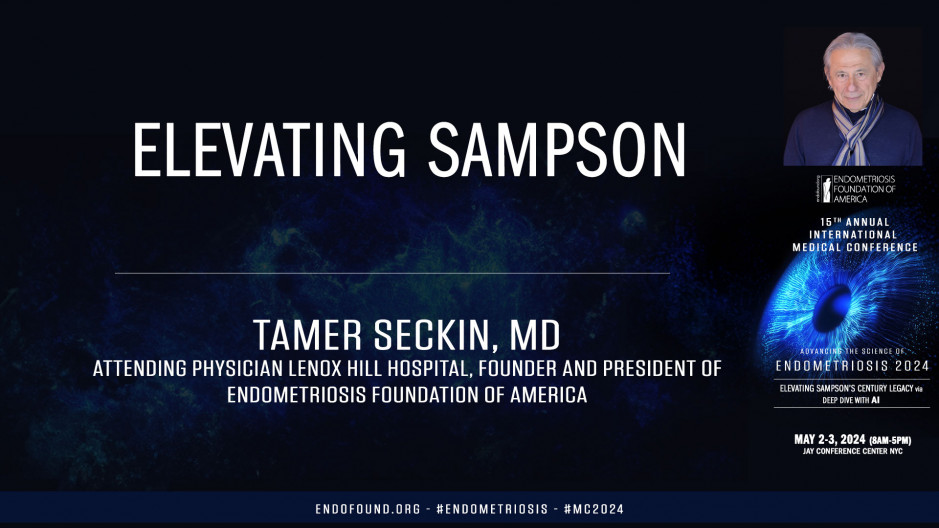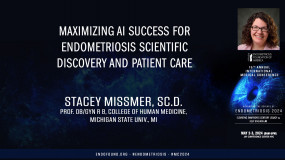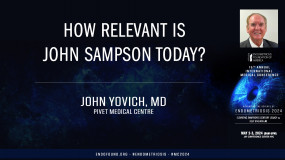International Medical Conference
Endometriosis 2024:
Elevating Sampson’s Century Legacy via
Deep Dive with AI
For the benefit of Endometriosis Foundation of America (EndoFound)
May 2-3, 2024 - JAY CENTER (Paris Room) - NYC
I like to start. First of all, I felt like a butter and a hot pan when Dr. AK introduced me. I don't deserve and none of everything he said, but I do bring people together that has been in my nature. It's probably because I am a clinician at the endometriosis foundation. I started actual 2006 and Padma joined me after I did her surgeries. She made us public. So she was very angry. She had multiple surgeries. She didn't know she has endo So Padma got mad and she really initiated, let me join you and let's do this. This is really not nice. And she's a very progressive woman and I salute him. I recognize what she did for us. She made us public. So Endone is really advancing the science and surgery of users. And I think it's the first concept that brought scientists and surgeons together in a charity organization. I really recognize what was done before, and we started this with the first ball, was we brought attention with this first ball. Very Zaria Will Berg was there, but most importantly it was Harry who introduced me to the world of endometriosis. And I met very, very notorious scientists and surgeons around the world. My eyes really opened up that there was some vacuum and energy that was needed there. And this is Belgium. I met Dr. Dne. Harry took me there. I never forget. Suddenly many stars popped out in my eyes. And it's important that many of these people are alive and some are gone. But it was important for me to be with Coach Sam, Jordan Phillips, Ray Gary, Chris Sutton, Philip Connick, and Donne, who's with us.
We did every year we recognized the individuals who had great input. This is Metler, she's not here, but Linda Judi. We honored individuals, and recognized them. We brought attention to the field. We really did. Very nice titled conferences. Our first conference was from stem cells to radical excision surgery, which I thought very interesting. And then we focused on many, many good topics. I thought that created very interesting conversation. We did patient panels, we brought patients, and we still do it every year. And it's the impact of educated, ungrateful patients who made us visible in the Washington Post Newsweek and New York Times, whether it was lung case or kidney loss and everything. And these celebrities, some of our from our clinic, but most of them are from our but did voice their concern about the disease and make us visible. And Padma went along, talking about in certain universities to bring awareness.
We were part of New York City Marathon. We raised this year more than $250,000 by runners. So that goes to research which we will be announcing today. We started this Empower program. We really educated close to 40,000 New York City, city students about reproductive health and its connection to endometriosis. And it became a law in New York, a mandatory high school curriculum by Chris Cuomo in New York State endometriosis mentioned in high school educational program. We want to bring this program nationally and globally by e-Learning by Empower program. So this meeting is about Samson. Samson has been the guidance compass for me because he was a pathologist. He observed things that his peers did not, and he argued with them. He didn't let go. He was tenacious and he made his point In the end, we prove today, a hundred years later, we think so is right. And everything he did about menstruation. Every research is about menstruation and endometrium right now. So with ai, this future is now AI is going to be very interesting. We all feel ai. I think if you live enough, we may find some longevity there that we could benefit. So take care of yourself guys. So moving on.
Artificial intelligence is not artificial insemination, but it is intelligence exhibited by machines, by computer system. It was already with us. A lot of cutting edge. AI has filtered into general publications already, often without being called ai. Because once something becomes useful enough and common enough, it's not labeled AI anymore. But there has been revolutions among older revolutions, steam power, electric power, electronics, this digital revolution starting with internet. Now jumping to AI is a little bit scary maybe because just recently, April 24, dude from somewhere PhD claimed that he has the evidence that we live in all simulation. It is scary. I mean you all remember the film matrix. Thomas Anderson discovers a truth to end all truths. That universe is simulation and this scientist claims he has the proof. Are we really living in a simulated universe with artificial intelligence? Coming to this stage I think is inevitable and I think it's scary.
It's going to be fight of good and evil and humanity may get squeezed, but we have to be optimistic. So this is just recent publication in Lancet this month. It's coming. I'm not sure it's in the internet. I just found it. This is a review talking about the randomized control trials and artificial intelligence in clinical practice. There's exponential interest all over the specialties with a focus on deep learning, mainly on medical imaging, particularly GI and radiology. And almost 80% results are positive, inevitable. Hope that in the end, AI trials will be prioritizing focusing on patient relevant outcomes in order to fully understand its true effects and limitations in healthcare.
What do you see here? Well, we see a lot of things. We see angiogenesis, maybe fibrosis, maybe a lesion somewhere here. If there was a sound in this picture, it would be saying what would be sound saying to me as a clinician? It'll be saying, I have pain. I'm crying, I'm screaming in pain. Is anybody hearing me? So we are going to go to this. There is inflammation here, there's fibrosis, there's everything. We are going to talk about this maybe tomorrow in better pictures. So this is a quote from Susie Asani from, we all know Susie, exceptionally wonderful human being and surgeon, I'm going to read this. I am going to focus on surgery. She had it enough. As a surgeon, this is such a complex disease. She has to say it. I am going to focus on surgery and surgical data today. My focus on surgical science is not to distract from the suffering of those with endometriosis.
After years of neglect, roadblocks, gaslighting, isolated islands of care in America, that's like everywhere else. Complex cause of pain causing information, extra pelvic symptoms, non menstrual symptoms, insurance and everything. So I think AI will help in the end. So we have significant duty of working together. That's why we are here today. And I think this is a great opportunity with your participation. We are opening this window and foundation will be moving in that direction. I personally think as a surgeon, AI will help lesion recognition in the smallest physical attribute. It'll help surgical technique which will result in improved outcome and preventing complication. And really we'll see multiple data in our consoles when we do surgery. I'm not a DaVinci guy. I don't like robots. Robots for many reasons that we are, but it's inevitable. I use robot, but I hold myself. My younger associates pushes for it. We continuously fight because I don't feel like something is missing that I'm not giving to the patient with robot for other things. This conversation is eternal, can go on. But this is interesting. I am not a speaker for Apple, but I tested this. I tested this in or I tested it in the clinic.
It's interesting because the goggle has 12 cameras and it's focused on your pupil movements. It has the resolution of less than even one millimeter. It reads your pupil movement and can grab a scene on where you are looking goggles like Tesla moving 120 miles an hour. It'll be better and better with this Nvidia coming and everything. So this is Apple's M1 and N two chips. Apple now M four chips. So it's like iPhone. That was, everybody has negative things about iPhone initially. No, we can't live without iPhone. I think this is going to come to quickly. It's going to be part of our system. Probably these robotic company will. This is a technical, this is really like Tesla scanner. You can take spatial pictures with it. You can record, you can connect multiple screens. Unbelievable. I bought this just I didn't give it back. I'm using it. It's nice to get away from at home. It gets me to a corner. I hide.
My wife is not here yet, so that's good. Okay, so the visual, this is red wines coat red wine. And I may not have agreed again many things, but he was a very fine man. He has the best way of describing things. He said the visual appearance of endometriosis is important because every intellectual and therapeutic process begins with surging identifying the disease. So if you don't do that, there's going to be confusion. I'm not going to read all his comments, but he was good enough, good to go for. And Dan Martin, they really worked on the visual recognition of endo from pigmented and occult lesions. And most endometriosis occult, actually it's not pigmented and they'll talk tomorrow about peritoneal endometriosis uses. So this is interesting. So I have probably over close to 50,000 pictures in the last 25 years. I take maybe multiple pictures. This is a program we are working on AI detection of the lesions.
So huge database. So this is a computer detecting lesions around. This is the first very prototype, but this is what a lot of people are working on this, I have to tell you, but not an endo much. But this has been worked in GI system endoscopy and colon cancers. So you really can go as I showed you, as very, very fine lesions. And I use blue contrast behind the peritoneum to absorb the redness and the yellow fuse. So that brings the peritoneum very clearly to your surface because we are misguided, we are illusionary, sucked into the overpowering and overpowering and even blinding laparoscopic light with its reflection and the redness behind the peritoneum obscures our ability to recognize. That's for sure. Well, I don't want to go with this. John Jovi really told all about the history, but Samsung really did not have good time with these mean looking guys who did ceramic metaplasia embryonic, really? The guy by himself fought with them. And these were no wax, Myers cooling.
And he was ahead of his peers. I can tell this much. He did. Oops, sorry. So summarize Sam. In my terms, he did define inflammation. He did define fibrosis. He did define metaplasia, which today we think all stem cell, we know that most likely, right? So Sam was ahead of his time for that hat off. So this Samsung retrograde menstruation hypothesis is distinct from other hypothetical explanations of pelvic organ, which remained at level educated guests without an reproducible scientific proof. Lum said this following, following this is I do my surgeries always during the time of periods. I try to come on.
It is not minimal retro greatness. These patients have significant retrograde bleeding donate in their prime article. They questioned it. They said the volume of if I'm wrong, I remember that the volume on retro greatness should make a difference. It's all about physics, but we are away from those realities, which we should consider those unexplored aspects of endometriosis. So Bolen and many others for the last 30 years studied the stromal cells of endometriosis and compared these to those match endometrium of patients with endometriosis or the endometrium of disease-free women. So in other words, these set of observations really led to for him. He did write editorial following particular publication from Proteos that was published almost 18 months ago or so. So proteus in this issue of fertility and sterility presented important new data complementary to earlier work and provide convincing DNA evidence that superficial endometriosis, well I don't like superficial endometriosis, but it is the term peritoneal endometriosis. Deep infiltrating and endometrioma removed from the same patients, share the same genetic makeup suggesting that these various various lesion types originate from the similar or identical oligo clones of endometrial tissue. So retrograde menstruation is now a scientific fact with evidence, a proven theory.
Do we have one endometriosis for surgeons like me? I like to believe like that. But because we are clinicians, we treat patients with that attitude. We may be wrong.
Is there one disease? Is there one theory? Is there one root of treatment? I took the root from a publication of San, we'll come to that. That's a big question, which this is not true. Most likely it's not true. But we surgeons have to treat endometriosis as one disease because we excise, we remove the disease. The patient have all the same symptoms because the symptoms of pain cannot be classified or staged. Minimal endometriosis may have the same amount of pain with extensive endo and extensive endo may not have any pain. So underlying pathology mechanism from this publication is defectively programmed endometrial chy stem cells. So on the contrary, Dr. San Diego said maybe this is not the situation. It was a beautiful article that AU and Dr. Ano complimented his work and provided critical appraisal, which basically Sanwell said, and he may be working talking about this also in a different way, but it probably is not enough to explain this theory by itself because it's not the changes endometrium itself. Maybe it's the disease that's formed already changing the endometrial architecture and causal.
I had to read this many times to understand what they're saying, but I think have a little grasp of it. Please excuse me. But we did come with this article. However, my clinical, I was part of this original study actually out of this 23 patients, 17 of them were mine. I'm done. Almost 17 of them was mine and it is, and these patients have all had advanced endo. And we did this work with John Hopkins. It's been published, one of the most referenced articles in this similar thing. So I'm almost done in our inoperative incidents, unintended consequences, complications, Cardinal since here's an example. This is a patient who came to us from John Hopkins with a chest tube. We are removing, she's still have pneumothorax and she's been repaired before with a robotic approach. We are going, you're going to see something terrible happening here in a second, and I'm not going to tell you, but the thing is, what is happening here is patient lost immediately, within 20 seconds, almost half a liter of blood. So you see this robotic arm, he's mobilizing. He doesn't realize what is behind this. The liver surgeon. And he uses energy to mobilize because there is a hole behind it actually. However, what is going to happen? I cannot fast forward here, I'm sorry, but two seconds I'll be there. Watch what's going to happen.
Almost done. 20 seconds. I wish I could fast forward this. So it is repaired section of their work on the diaphragm. There's still endo. There's still holes here, which you don't see. This is what happened, guys. Okay, we hit the IVC. Everybody came. I'm not going to tell you how we handled this. This is handled so beautifully and this has never been published. Tomorrow I'm going to show you the rest of the video. AI will help with ai. We'll know what's behind it. AI will tell us what's behind what we see. I really think a lot of complication will be, I can tell you I use ICG Green for my ureters all the time. Cystoscopy. I cruise for lys 10 times faster with confidence. Anytime I can activate that final slide. This is from Ernest Hemingway, Benini Bahamas, which I was mesmerized to see this he wrote from Spain. Maybe all you have to do is write one true sentence. Write the true sentence that you know. Thank you Samson.










